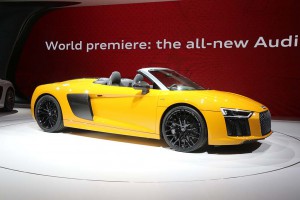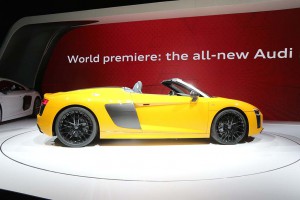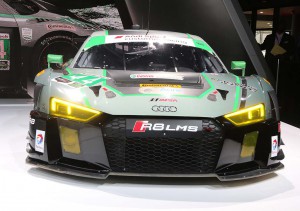There are plenty of folks who love the Audi R8, and that includes Scott Keogh, the brand’s U.S. CEO. Audi was little more than an asterisk on the sales charts. Today, it’s a force to be reckoned with, sales growing 250% since the launch of the sports car nearly a decade ago.
While it might target a small niche, “The R8 put Audi on the map,” says industry veteran Keogh, helping the brand “put old luxury on notice.”
Audi has three versions of the R8 on its stand at the New York International Auto Show this week, including the daunting, 610-horsepower Audi R8 V10 Plus, as well as the R8 LMS race car. There’s also the brand-new member of the family, the 2017 Audi R8 Spyder.
(Click Here for complete coverage of the 2016 NY Auto Show.)
The 205 mph V10 Plus is a race car for the street, its engine “virtually identical” to the LMS race car, but for its clutch and a mounting flange.
The new R8 Spyder is a wee bit more tame – if one can use that word to describe what is still a 540 horsepower two-seater capable of hitting “nearly” 200 miles per hour.
And it can do that even with its top open, noted Audi officials during the debut of the R8 Spyder. The ragtop can be raised or lowered in just 20 seconds – and at speeds of up to 31 miles per hour, meanwhile. And there’s a deflector to keep one’s coif in perfect shape even when the throttle is pressed to the floor.
But it won’t keep you from hearing the guttural roar of the 5.2-liter V-10 which makes 540 hp and 398 pound feet of torque. “Listening to its engine is like listening to music,” sighed Dieter Goggenreiter, the Audi member overseeing sales. If you prefer some regular tunes, there are speakers integrated into the Spyder’s headrests.
(Jaguar tops 200 mph with the new F-Type SVR. Click Here.)
As it did with the earlier version of the R8 Spyder, Audi eschewed the hardtop approach favored by some competitors, opting instead for a more conventional soft roof it was able to engineer to add a mere 97 pounds of mass.
The entire R8 line-up recently went through a redesign, and the new addition, the aluminum and carbon fiber Spyder is both lower but a bit more than an inch longer than the model it replaces.
Both the Spyder and the V-10 Plus have adopted a variety of new high-tech features, including Audi’s Virtual Cockpit, a 12.3-inch reconfigurable display that replaces the conventional gauge complex. Among other things, it can display the same, Google Map-based navigation display otherwise visible on the center stack’s touchscreen. The cockpit’s gauges shift depending upon what mode the R8 is operating in.
Audi owes a tip of the hat to sibling brand Lamborghini, sharing many of the R8’s underpinnings with the Italian automaker’s latest-generation Huracan model.
The German marque recruited Lamborghini’s long-time CEO, meanwhile, Stephan Winkelmann coming on as the new CEO of the Audi Sport unit that oversees high-performance models like the R8. Speaking at a news conference at the New York Auto Show, Winkelmann noted the U.S. market “has the potential to be the number one market” for Audi’s sport models in the very near future.
Considering Americans top the list for BMW’s M and Mercedes’ AMG lines, that isn’t a big stretch, especially with the addition of new models like the R8 V10 Plus and the R8 Spyder.
(Click Here for a look at the more powerful, updated 2017 Nissan GT-R.)



